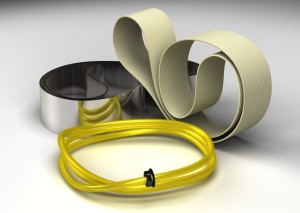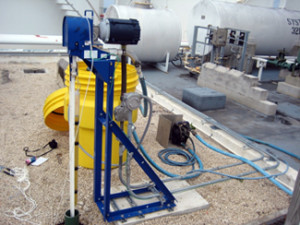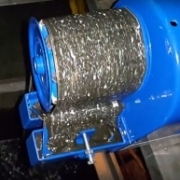Oil Skimming for Wastewater Recycling
Oily Wastewater Disposal & Recycling
As large generators of oily wastewater tighten effluent controls, the U.S. Environmental Protection Agency (EPA) is targeting smaller generators. Some of the firms receiving their attention are smaller manufacturing plants, automotive garages, mobile equipment service shops and truck farms. Many of these firms do not have access to a sanitary sewer system that will accept oily wastewater.
Because disposal in storm sewers also is prohibited, they frequently use injection wells, septic system drainfields, dry wells and ground pits to dispose of oily wastewater; one EPA concern is that oily wastewater will find its way into an underground aquifer that is a source of drinking water.
Many oily wastes contain organic and inorganic chemicals in concentrations that exceed the primary drinking water standards established by the Safe Drinking Water Act. So the focus of one EPA program is aimed at preventing contamination of groundwater by controlling oily wastewater recycling at the generator’s site.
Download Oil Skimming Factbook
The industry’s most complete guide to selecting and sizing an oil skimmer for your application.
Similar problems are faced by plants that must deal with fugitive oils. These are oils that enter wastewater as a result of leaks, spills and housecleaning operations.
Examples of Fugitive Oil
|
Type of plant or application |
Typical source of fugitive |
|
Primary metal mills |
Rollout table grease in cooling water. |
|
Paper boxboard manufacturer |
Machine bearing and gear lubricants. |
|
Plastic molder |
Injection machine hydraulic fluid. |
|
Food processor |
Vegetable oil, meat fat and frying oil. |
|
Groundwater remediation |
Petroleum distribution spills and leaks. |
For metalworking plants, there are additional concerns associated with tramp oil in aqueous parts washer fluids, coolants and cutting fluids. For these plants, whether connected to a sanitary sewer or not, recycling wastewater may be the most viable option. In metalworking plants, the primary concern may be reducing purchased fluids and operating costs, which can be achieved by removing tramp oils to extend fluid life. Coincidentally, this also reduces disposal costs.
Getting Rid of Oily Wastewater
If oily wastewater isn’t recycled, it must be disposed of safely. One option is to have it collected and hauled away by a licensed disposal firm. The annual volume of oily wastewater generated by many shops and plants makes hauling too costly.
Even firms connected to sanitary or industrial wastewater sewer systems have limitations on the oil content in their effluent. When oil concentration exceeds a certain level, usually 100 ppm or less, the generator can get hit with hefty surcharges by the local government providing wastewater treatment.
At some level of oil concentration, the oily water effluent is prohibited from entering the sanitary sewer line.
Wastewater Recycling
With wastewater recycling, the most common methods of oil/water separation include decanting tanks, oil skimming, coalescing, membrane separation and various chemical treatments. Any of these methods can be effective. Selection should be based on economic as well as technical considerations.
Although it is a cost effective method of reducing contamination, oil skimming often is overlooked as a primary technique. Frequently, this results from the misperception that skimming is only suitable as a pretreatment ahead of other oil/water separation devices.
Certainly, skimming is a retreatment method used to prevent oil overloads in downstream membranes, coalescers and sand bed filters. But it can stand alone as an oil removal method in many applications, reducing oil to only a few parts per million concentration, depending on conditions. In many locales, this is good enough to allow the water to enter a sanitary sewer system without paying connection surcharges.
More exotic methods of oil removal, such as membrane filtration and chemical treatment, are most often required when tight emulsions and other chemicals must be removed. If an emulsion is the water-in-oil type, a skimmer may do the job.
Types of Oil Skimmers
Oil skimmers usually incur a low initial cost, install easily, offer rugged construction, reliable operation and minimal upkeep. Training personnel for operation, monitoring and routine maintenance is nil.
Still, there are different types of skimmers, and each application requires some analysis to make the best selection. Also, the water collection system must be set up properly in order to get maximum performance from the skimmer.
The six major skimmer configurations for industrial plants and service shops are belt, disk, drum, mop, tube and floating suction types. For all types, the oil or other hydrocarbon liquids must be floating on top of the water. For all but the floating suction type, a moving skimmer medium is pulled through or across the surface to attract the oil.
This oil is then removed as the medium is pulled through wiper blades or scrapers by a motorized drive system. The skimmed product is discharged through collection trays and drain channels into an external container.
Oil Skimming System Designs
Reservoir Design
Because skimming acts on floating oil, the water must be in a reservoir where separation can occur. The reservoir should be designed with quiet areas, weirs and sufficient volume to allow adequate residence time for oil/water separation. Avoid turbulence by having water return to the reservoir below the liquid surface at as low a velocity as practical. Tanks without nooks and crannies for oil to accumulate in are best.
If you have an irregular shape, put the skimmer where the largest amount of oil accumulates. Consider a means of directing oil toward the skimmer medium to improve removal efficiency.
Turbulence
All skimmers work more efficiently in quiet water with a relatively thick oil layer. The greater the turbulence, the lower their efficiency due to emulsification. Turbulence also affects the physical performance of a skimmer. For example, a tube shaped medium may get kinked due to turbulence, which could cause damage or impair its drive mechanism.
Mop type oil skimmers may require a tail pulley with its axle secured to the side of the tank. Belt types may be fitted with a tether or stabilizer bar assembly to resist twisting of the tail pulley.
Reservoir Depth
Most skimmers are installed in existing reservoirs. When this is the case, there are two important aspects of liquid depth that must be considered: fluctuations and minimum operating level. Disk and drum skimmers can handle only minor fluctuations, limited by the radius of the disk or drum. This dimension also determines the minimum usable depth.
Other types can handle liquid fluctuations between the reservoir’s maximum and the skimmer’s minimum usable depth. The minimum depth for belt types is between one and six inches, depending on belt size. The minimum for mop types is about three inches. Unless the tank level fluctuates severely, tube types will work down to the point where the tube is beginning to drag the bottom of the tank.
However, turbulence and extreme level fluctuations can cause snarling of the tube near the bottom of the tank. The floating suction type is limited by the design and size of the flotation device, which may have more than a foot of the assembly below the surface.
Installing an Oil Skimmer
The biggest installation issues are the amount of space required and cost. With regards to space, there are two areas that need to be considered: mounting area and water surface area. Installation of a suction skimmer also may involve sensors and a control box.
Moving medium skimmers require some sort of rigid mount on or near the reservoir. Some require the drilling of holes into the tank, which can be costly, depending on the reservoir design. Because of drive design, drum types tend to require more elaborate mounting methods and space. Belt, disk, tube and mop drive units consume a moderate amount of space.
An advantage of some belt skimmer drives is the use of a flat surface mount or bracket, neither of which require tank modifications. Mounting stands, brackets and adapters help make skimmer installations easier and faster.
Portability is a plus in some applications. For example, in plants and mobile equipment service shops, a portable skimmer can sometimes service both a parts washer and a drain water retention sump.
Belt and disk type skimmers tend to be the best designs for portability, and can be made small enough to weigh only a few pounds.
As most hydrocarbons spread fairly quickly over the top of water, it is not necessary to use more of the surface than the skimmer medium contact area. However, a skimmer’s design may actually take up more of the surface than the minimum required. A drum skimmer may require up to five square feet depending on drum size.
A tube skimmer requires four to five square feet due to the tube snaking out over the surface of the liquid. Unless a mop medium is constrained by a tail pulley, it moves around and takes up surface real estate. This is particularly true when there is turbulence.
Disk skimmers generally require from one-half to one square foot of liquid area.
Belt skimmers require from a few square inches to about one square foot, which is determined by the belt width and diameter of the tail pulley.
Maximum Lift Distance For Skimmed Material
Belt type skimmers can raise skimmed product 100 feet or more without the use of a pump, which is handy when the collection receptacle needs to be located above the reservoir’s surface. For example, the size of a steel mill descaling water tank and its large level fluctuations may require skimmed oil to be lifted more than 50 feet.
Drum and disk types require a separate pump to raise oil above the collection tray, which is near the fluid surface. Mop and tube types work satisfactorily for lifts up to about 50 feet. A floating suction type is constrained by the pump’s maximum allowable pressure head, which depends on the type of pump used.
Removal Rates
As a rule of thumb, select a skimmer with a removal capacity that is twice the maximum anticipated influx rate to allow for surges. For example, if 200 gallons of oil have to be removed in a 24-hour period, that averages out to about 8.3 gallons per hour. However, if all that comes during one eight-hour shift, a removal capacity of 25 gallons per hour or higher may be needed to keep up with the influx.
The removal rates for different skimmer designs cover a wide range. Disk skimmers can be designed for removal rates below one gallon per hour. Multiple belt types have removal capacities as high as 200 gph.
Residual Water
Depending on the disposition of skimmed product, water content can affect the amount paid or charged by the recycling company that removes it. For example, if the generator or a salvage firm wants to recycle used oil as a lubricant, then low water content eliminates a separate step and reduces refining costs.
When there is a relatively thick layer of oil, moving medium skimmers normally pick up less than 5 percent water in the skimmed product. Still, a decanter tank may be required if the application tolerates even less. A decanter is a secondary reservoir for the skimmed product that provides virtually complete separation by allowing removal of water below the surface while oil flows off the top. Some skimmer manufacturers provide these tanks as an option for their products.
Floating suction oil skimmers are most suitable for relatively thick layers of oil, say, greater than 1/4 inch. If the layer gets thinner, a suction skimmer may need sensors and controls to shut off the motor to prevent the ingestion of a large amount of water, particularly if there is turbulence in the reservoir. Also, water and oil tend to emulsify due to churning as they go through the pump. Because of this, a suction skimmer may require a large decanter tank and/or coalescer.
Skimmer Media

Media material is a key feature that helps determine a skimmer’s suitability for an application. The most important liquid parameters affecting media selection are temperature range, pH and the presence of solvents.
Most skimmer manufacturers offer polymer media, some also offer stainless steel. Cost is a consideration as any medium has to be replaced from time to time. In tube and mop skimmers, the user is restricted to polymer because of the medium’s shape. Belt skimmers can use both media types, and depending on design, may allow easy switching if one proves unsuitable.
Some designs allow a change of media type without changing pulleys. Others require different pulleys for different media, making modifications more difficult.
Polymers
Polymers are good for applications where abrasive particles are present, or when physical abuse can occur. It is advisable to use this type of media in hazardous duty applications, such as monitoring wells where gasoline is present — steel media has the potential for creating a spark and igniting fumes.
A polymer medium generally is not suitable for temperatures above about 180°F, or where strong solvents such as ketones will be in the skimmed material. Some tube shaped polymer media are coated with an oleophilic material to improve oil adhesion, which may diminish over time as the coating is scraped off by the wiper blades or debris.
In mop configurations, polymer fibers may get matted down fairly quickly by higher viscosity oils, reducing removal capacity.
Some polymer media are laminated to improve resistance to stretching. Lamination also adds dimensional stability to resist bending, rolling and twisting caused by turbulence or debris in the water. To avoid problems with delamination, which is accelerated at higher temperatures, some manufacturers use a single layer of a specially engineered polymer that has higher strength and heat stability.
Stainless Steel
Stainless steel is reliable in high temperatures, acidic and alkaline solutions and in solvents. It also is a good choice when the skimmer will be shut down for substantial periods, as it resists corrosion due to prolonged air exposure.
Suitability for the Application

In outdoor applications, the use of heaters may be required to keep skimmed product fluid so it can be effectively removed from the medium and collection tray. This is particularly true for grease skimming, which involves higher viscosity at all temperatures. Polymer materials are limited in their heat tolerance, so skimmers equipped with these media may have only tray heaters.
Skimmers with steel media can apply heat to both the tray and the medium, which improves performance in severe winter climates. To resist corrosion, a stainless steel housing also may be needed. Above ground enclosures and underground manway mounting kits provide additional protection from the elements.
Commonly used materials for wiper blades are nitrile, [CRV] and ceramics. Nitrile is suitable for use as high as 176° F in neutral pH liquids. For higher temperatures and acidic or alkaline liquids, [CRV] wipers work well. Ceramics are resistant to more chemicals, but are prone to breakage.
For hazardous duty locations with ignitable fumes, explosion-proof motors are mandatory. Special corrosion resistant motor housings may be required for sanitary washdown situations in food plants. Different voltages and power frequencies are needed for some plants.
In many applications, skimmers can run unattended for days or weeks. This is typical for groundwater remediation applications at remote well sites. When controls are used,
they tend to be either manual on/off switches or 24-hour timers to start and stop the unit at predetermined times.
Skimmer Reliability and Maintenance
Skimmers require a certain amount of routine maintenance, primarily periodic cleaning and checking wiper blade adjustment. Easy removal of safety covers shielding the moving medium and its pulleys will reduce maintenance time.
In terms of drive designs, those with separate gear reducers tend to be somewhat more robust than unitary gear motor drives. Chain drives, which are found on a few models, need to be lubricated regularly and the chain should be protected from debris and other impediments.
The Bottom Line
Regardless of application, the primary reasons to wastewater recycling are economics and the desire to be a good environmental neighbor. Because economics plays such a pivotal role, the recycling method has to be cost effective over its entire life cycle. That includes original purchase price, installation costs, operating expense and maintenance costs. Cost effectiveness also is measured by the residual oil concentration in the wastewater.
Oil skimming can be evaluated as a stand alone treatment method, as well as a pretreatment method for more exotic oil/water separation technologies. In many applications, it can provide acceptable water quality by itself.
by M. Thomas Hobson, Managing Director
Abanaki Corporation; Oil Skimmer Division




